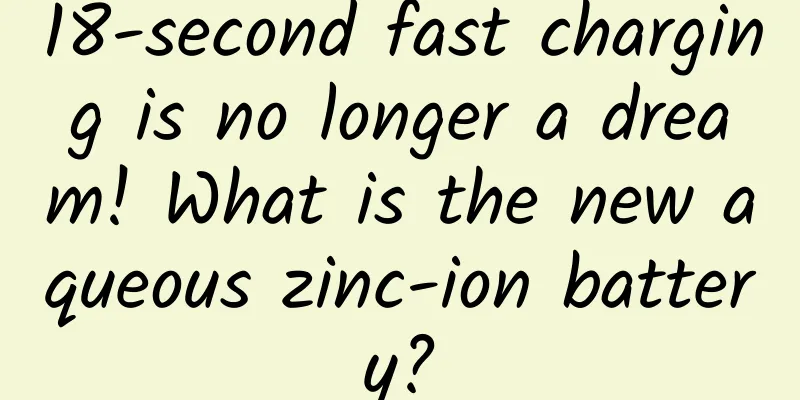18-second fast charging is no longer a dream! What is the new aqueous zinc-ion battery?

|
Produced by: Science Popularization China Author: Dong Shaoxiang and Wang Yixiu (University of Science and Technology of China) Producer: China Science Expo Mobile phones, computers, tablets, etc. that use batteries as their energy source have become part of our lives. More and more people are beginning to suffer from "battery anxiety". At the same time, the accelerated popularization of new energy vehicles has also made people increasingly unable to tolerate the long charging time of batteries - faster! The battery charges faster! This has become everyone's common wish. Battery anxiety has become one of the sources of anxiety in this era (Image source: Flickr) This wish may soon come true. Recently, Professor Song Li's team at the National Synchrotron Radiation Laboratory of the University of Science and Technology of China developed a battery with fast charging capabilities. Today we will talk in detail about this scientific research result. 1. Zinc-ion battery VS. lithium-ion battery Lithium-ion batteries are a type of energy storage device that is widely known. With advantages such as high energy density and wide operating temperature range, lithium-ion batteries have occupied the vast majority of commercial batteries. However, the organic electrolyte used in them is harmful to the human body, and the shortage of lithium resources will lead to a situation of supply exceeding demand in the battery market in the future. As a newcomer in the energy storage industry, zinc-ion batteries have both high theoretical energy density and non-toxic aqueous electrolytes, which ensure safe and efficient production and application. In addition, cheap and abundant zinc resources have greatly reduced the cost of using batteries, and are expected to become a potential substitute for lithium-ion batteries in the future. Even though there are many differences in the use of materials, the working conditions of zinc-ion batteries and lithium-ion batteries during the charging and discharging process are very similar. The positive electrode material of the battery is often layered: during the discharge process of the battery, lithium ions (or zinc ions) will be embedded in the interlayer of the positive electrode material for storage; and during the charging process of the battery, lithium ions (or zinc ions) will escape from the interlayer of the positive electrode material and return to the negative electrode. In summary, the working principle of the battery is a process of ion migration and electron transfer. How Lithium-ion Batteries Work (Photo source: veer photo gallery) 2. The principle of fast charging of batteries So how was the fast-charging battery achieved in this scientific research achievement? Broaden ion transport channels As mentioned above, the charging and discharging process of zinc-ion batteries is a process of continuous ion migration. If you want to store as much battery capacity as possible in a short period of time, you have to create a larger storage space for zinc ions. First, the researchers focused on layered vanadium pentoxide materials with adjustable spatial structures. The structure of this layered vanadium pentoxide material is like a series of parallel plates. In order to increase the interlayer spacing of the layered positive electrode material, larger ammonium ions can be pre-intercalated. This means adding some pillars between these layers in advance to increase the interlayer spacing. With the support of ammonium ions, zinc ions can migrate more easily in the positive electrode material, and the larger interlayer space can also effectively increase the energy storage capacity of the battery. Schematic diagram of the structure of ammonium intercalated vanadium pentoxide (Image source: Reference 1) From adjusting orbital occupancy to accelerating electron transfer It is important to know that the energy storage process of the battery is closely related to ion migration and electron transfer . When zinc ions enter the interlayer of the positive electrode material for storage, some electrons will also be transferred to the positive electrode material to maintain the overall charge balance. Therefore, it is also very important to study the effect of intercalated ions on the electronic structure of layered materials. However, it is difficult to clearly explore the atomic and electronic structure of materials with traditional testing methods. Therefore, more advanced synchrotron radiation characterization technology is needed for detection. In simple terms, we can understand synchrotron radiation technology as an enhanced version of a "super microscope" that can clearly see the internal structure of materials by using its high brightness and wide band characteristics. Using this technology, the researchers explored the changes in atomic orbital occupancy in vanadium pentoxide materials after the insertion of ammonium ion pillars between layers and the reversible evolution of the material during the charge and discharge process. Here we first introduce the basic concepts of electronic structure. For elements with extranuclear electrons, the electrons they carry are not randomly arranged, but arranged in orbits in sequence. Moreover, electrons always occupy low-energy orbits first, that is, they are arranged from the inside out with the nucleus as the center. For the element vanadium, its valence electron configuration is shown in the figure below, with 5 valence electrons in the outer layer. In the vanadium pentoxide material, these 5 electrons are used to form bonds with oxygen atoms. At this time, the 3d orbital of vanadium is an empty orbital that is not occupied by electrons. Vanadium (Photo source: veer photo gallery) With the help of synchrotron radiation technology, the researchers clearly saw that the insertion of the ammonium ion pillar distorted the crystal structure of vanadium pentoxide and changed the original VO bond length. Most importantly, this structural distortion also changed the electronic structure of vanadium, causing electrons to jump to the originally empty V 3d orbital, resulting in the V 3d orbital being partially occupied. However, this part of the electrons did not serve the oxygen atoms, but significantly improved the conductivity of the material . Combined with what has been said before, during the battery charging and discharging process, there is both ion migration and electron transfer. Synchrotron radiation characterization shows that the vanadium pentoxide positive electrode material after ammonium ion intercalation exhibits a reversible evolution law during the charging and discharging process. During discharge, electrons are transferred to the positive electrode material, resulting in further occupation of the V 3d orbital, while during charging, electrons are detached and the V 3d orbital can return to its original occupied state. However, this reversible change in orbital occupancy has not been observed in the original vanadium pentoxide material. In summary, the change in electronic structure not only improves conductivity and greatly accelerates the flow of charge , but also improves the reversibility of battery charging and discharging, and further combines the acceleration of zinc ion migration by widening the interlayer spacing to achieve the fast charging characteristics of the battery . Dual regulation of crystal structure and electronic structure makes fast charging and stable cycling a reality When using this new cathode material, the zinc-ion battery achieved a capacity of 101 mAh/g at a current density of 200 C, and charging only took 18 s. At the same time, the aqueous electrolyte also ensures safety during the cycle and reduces pollution to the environment. The paper designs and regulates the interlayer spacing and orbital occupancy state of layered materials from the perspectives of the material's crystal structure and electronic structure. At the same time, it combines advanced synchrotron radiation characterization methods to more intuitively and clearly illustrate the evolution of the material structure, making it possible to develop positive electrode materials with fast charging characteristics. Perhaps in the near future, this type of material can be applied to electronic products and even public transportation. The significant reduction in charging time can make people's lives more efficient and convenient; the safety and cleanliness of battery materials can also reduce the burden on the environment. I believe that technology will make this day not far away. References: 【1】Yixiu Wang, Shiqiang Wei, Zheng-Hang Qi, et al. Intercalant-induced V t2g orbital occupation in vanadium oxide cathode towards fast-charging aqueous zinc-ion batteries. PNAS, 2023, 120, e2217208120. |
>>: Are tumor markers “cancer indicators”? What should we do if abnormalities are detected?
Recommend
The efficacy and function of pig hair ginseng
Pig hair ginseng is a traditional Chinese medicin...
Sensing sadness, protecting companions, self-destructive behavior... How to explain the "self-awareness" of animals
© The Dodo Leviathan Press: Wikipedia defines sui...
The effects and benefits of burdock tea
In recent years, burdock tea has gradually appear...
My dear, why are you hibernating in the snow? Aren't you cold?
In the last ten months of winter, when the snow i...
7 kinds of "aging agents" hidden in daily food, try to avoid them!
Everyone wants to age more slowly, but in life, s...
Who is "obstructing" forest carbon storage? It's the microorganisms in the soil!
Popular Science Times (intern Wang Yuke) Forests ...
Characteristics of Dandelions
Dandelion is one of the most common flowers and p...
What are the effects and functions of fresh Dendrobium
Chinese medicine is very valuable and has many di...
Chinese herbal medicine for sterilization and anti-inflammatory
There are many types of Chinese medicinal materia...
Beware! This commonly used medicine increases the risk of fractures and diarrhea!
Expert of this article: Pan Kunming, Master of Ph...
The efficacy and function of Duxianzi
Do you know Duxianzi? It is a common Chinese medi...
AI draws quickly and well, so how does it draw?
Welcome to Science Popularization China’s special...
The efficacy and function of the smile flower
Do you know about the smiling flower? It is a com...
Overeating again on the weekend? The harm of eating too much often is greater than you think
People always eat too much easily, sometimes beca...
Can you hypnotize a chicken by drawing a line in front of it? What kind of outrageous hypnosis is this?
In a video, we can see the following scene: A chi...









